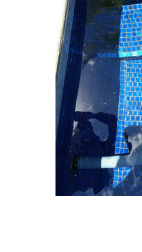
I met the customer at his rental property and took a look at the pool. At first glance, it didn’t look that bad. The water was clear, not crystal clear but clear enough. There was some debris laying on the bottom and few leaves and dust floating around the surface. The water level looked good and the circulation seemed to be just fine. I took a look at his equipment and it seemed pretty standard. A Whisperflo with ¾ hp motor and a DE filter. I told the customer how much I would charge for the pool, he agreed and I started his first service.
One of the first things I like to do is to brush the pool. As soon as I started brushing the sides of the pool large clouds of “black stuff” got pushed out of every swipe of the brush. I made it around the entire pool and his pool was definitely “all black.” I checked his DE filter and the pressure read over 30 psi. Not good.
I proceeded to vacuum the pool with my hammerhead equipped with a superfine debris bag. It quickly filled up blocking proper water flow negating any vacuuming effect that it has. I pulled it out of the water and removed the bag. There was a lot of black sand in it. I emptied it out and continued to vacuum the rest of the pool emptying the debris bag multiple times.
After all the beautification it was time for the chemistry. I took a full chemical reading and found the following results.
Free Chlorine
Above 10
Total Chlorine
Above 10
pH
Well Below 6.2
Alkalinity
0
CYA
0
Hardness
0
Now we have problems. First off, the Chlorine levels are way too high. Chlorine is a very corrosive chemical. When the levels are very high like this it can cause swimmer discomfort as well as shorten the life of the pool equipment. The pH was very acidic. This is also very bad for swimmer comfort and equipment maintenance. Just on these two factors alone anyone who would jump in that pool would be in a world of hurt. The Alkalinity and CYA was virtually non-existent. I was actually surprised that there was chlorine content with the CYA levels so low. I took the CYA reading a few different times with different test kits and came up with the same result. Finally, the Calcium Hardness was way too soft. With these readings the water balance is completely off the Saturation Index Calculator for the Taylor Complete Test kit on the side of “Corrosive.”
On a quick side not, the calcium levels in a pool are very important. Water is an amazing thing. It will do its best to balance itself out. If the calcium is too low, water will take that element out of anything it can, including plaster, grout, thinset, etc.
The water chemistry in this pool was without a doubt very off. Because of this, the pool water was trying to balance itself off and was eating away at the grout in between the tiles. With the grout failing, every brush of the pool would release all the grout into the pool causing it to turn black. The grout would then go through the filtration system causing the DE filter to fill up with this sand like material and drastically raising the pressure in the filter.
Going on a side tangent, I have seen this before. I picked up a handful of pools from a pool guy that was getting out of the business. Every tile pool he had had this problem. He obviously didn’t know his chemistry. One of the pools was so bad it would up costing the pool owner about 10K in repairs to re-grout and fix all his equipment. I wouldn’t be surprised if this new client would have to do the same.
Trying to recover from something as bad as this is very tough. All I can do is try not to brush the grout so hard or often and move the water to a bit more on the scaling side in terms of water balancing and hope the grout will hold up a little while longer or at least slow down this process. On my first service I added about 4lbs of Bicarb and 6lbs of Ash. I went back today to take another reading and the pH and alkalinity were still extremely low. It’s going to take a lot of Bicarb and ash to fix this pool.
 RSS Feed
RSS Feed